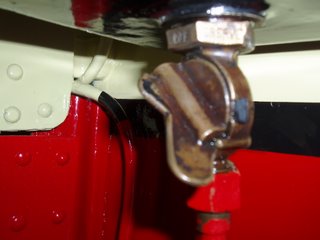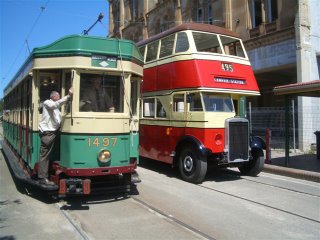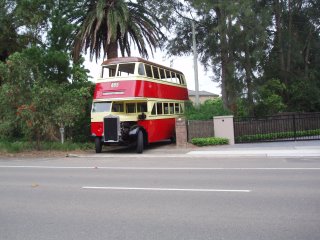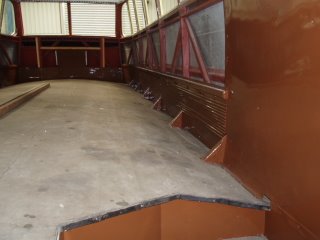Safely back in the garage at Turramurra, work on fitting all the bright parts could begin, and the job of applying Malthoid flooring to the bottom deck and rear platform.

THE BOTTOM DECK IS PARTIALLY RECOVERED IN ITS ORIGINAL 1937 FLOORING MATERIAL, MALTHOID. TODAY ONE CAN ONLY BUY TWO-PLY MALTHOID, WHEREAS WADDINGTONS USED 5-PLY. SO A FIRST LAYER OF THE 2-PLY ROOFING MATERIAL IS LAID FOLLOWED BY ANOTHER COAT OF BRUSH-ON SEALER AND THEN A LAYER OF THE DAMP COURSING WHICH HAS A SANDY FINISH. THE RESULT LOOKS THE SAME AS THE ORIGINAL AND IS PRETTY MUCH THE SAME THICKNESS. The centre aisle however has been laid with a single thickness of 5-ply from a roll 12" wide which came to me from I forget where years ago. The same roll has provided all the malthoid for stair treads, so I suspect it was a Government bus workshops stock item for just these purposes. In the distance it can be seen that the clutch housing does not align with the centre of the floor aisle: the engine, gearbox, drive line and differential are all offset to the left.
It is mildly amazing to me that a product like Malthoid is still around today, after being on the market for at least 80-90 years, maybe more. Today it is known as a roofing or damp coursing material, whereas in 1937 it was widely used for flooring, being waterproof and non-slip and hardwearing. It is bituminous woollen felt, dusted with sand if it is to be used as damp coursing. It was in this guise that it was used as flooring for all Sydney's buses in the 1930s 40s and 50s. Elsewhere in the world it is known as Pabco, Ruberoid, Ormonoid, and many other brand names. To hold it down one uses cut tacks and bitumen sealer in brushing form, and this stuff also does well as a preservative of the wooden floor boards: the bottom deck floor is original, after 70 years. A four litre can of sealer set me back $32 at Bunnings, plus 5 litres of turps to keep the brush clean. Also from Bunnings came blued cut tacks: an item of hardware not as easily found today it was 20 years ago.
Laying Malthoid is dusty, dirty, messy and not my favourite activity, but once done it is there for the next 50 years or so!

AROUND THE BOXES ENCLOSING THE REAR WHEELS AND DIFFERENTIAL WAS AN EDGING OF RIBBED RUBBER MOULDING. MY FRIEND DAVID WILSON IN HIS INFINITE WISDOM MANAGED TO SNAFFLE SOME STOCK OF THIS FROM THE GOVERNMENT BUS WORKSHOPS BEFORE THEY CLOSED THIRTY YEARS AGO, AND HERE IT IS, FORMING A CUSHIONED WEARING EDGE TO THE BOXING. IT IS TACKED IN POSTION AND THE MALTHOID IS LAID OVER IT, UP TO THE EDGE OF THE RIBBING. The hole in the top of the left hand box is an access hatch to the differential oil filler. In all English double deckers of the period, the drive line is offset to the left to keep the centre aisle floor level low.

Wheel boxes largely complete, and the hatch in place over the diff oil filler. Nearly ready for passengers to trample it down.
The other side of recent activity is fitting all the lovely chrome plated fittings for hand rails and posts, signal arm, sun visor etc.

ON THE BACK PLATFORM, SOME OF THE MANY HANDRAILS AND POSTS HAVE APPEARED. THE CENTRE ONE NEAREST THE CAMERA WILL NOT BE FITTED UNTIL ALL THE SEATS HAVE BEEN CARRIED INSIDE. THIS WILL BE ONE OF THE LAST THINGS TO HAPPEN, AS SEATS JUST GET IN THE WAY OF OTHER THINGS. THE RAILS UP THE STAIRCASE, WHICH WERE MISSING FROM THE BUS AS RECEIVED, WILL BE BENT FROM NEW TUBING USING THE ONES FROM ALBION 1615 AS PATTERNS. Compare this shot with the one of m/o 1629 taken in 1938, below, in "A Blaze of Colour". NOTE: You can save any of these photos to your own computer by clicking on the picture and, holding the mouse clicked, dragging the shot to your own desktop.

ANOTHER BRIGHT SPOT AMIDST THE GLOOM OF MALTHOID IS THE COVER OVER THE CLUTCH AND GEARBOX. LEYLAND WERE NOT AVERSE TO USING THIS AS A CHANCE TO ADVERTISE THEIR NAME, SO THE WORD APPEARS IN FLOWING SCRIPT ON AN ALUMINIUM ALLOY CASTING WHICH IS HIGHLY AMENABLE TO POLISHING. USING A BRASS-BRISTLE WIRE BRUSH IN AN ANGLE GRINDER THE WORST OF THE CORROSION AND SCRATCHES CAME OFF EASILY AND A BIT OF COARSE WETAND DRY FOLLOWED BY A FINER GRADE, THEN A STEEL WOOL SOAP PAD, THEN METAL POLISH BROUGHT IT UP FAIRLY WELL. A PROFESSIONAL POLISHER COULD HAVE MADE IT LOOK LIKE A MIRROR, BUT THEY WERE NOT LIKE THAT IN 1937.



























